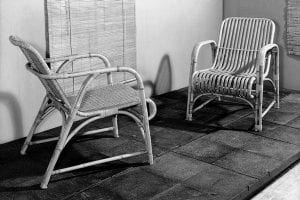Karen Fraser MA History of Design and Material Culture graduate (2019) reflects on winning the Design History Society Annual Essay Prize 2020.

Family photographs in the author’s cousin’s home, Vancouver. Personal photograph by the author. 9 Feb. 2016.
In July, I submitted a revised version of my dissertation, “‘That link to life, so to speak’: Older Women’s Expressions of Keeping through Photographs and Jewellery”, to the Design History Society (DHS) postgraduate essay prize, relieved to have made up my mind for the final time about how the sentences should flow. The prize provided the motivation I needed to reduce my 20,000-word dissertation by half and incorporate the feedback I had received from my assessors. I also reflected on comments from other readers – relatives and friends who wanted to know what had consumed my attention for so many months – and edited my work with those in mind as well. I was partial to the section on photographs and ended up leaving out jewellery for my essay prize entry.
In my dissertation, I took an anthropological approach to material culture in later life, studying what women keep and use to construct their homes in seniors housing, formerly known as sheltered housing. I interviewed three residents of a block of flats in Hove and took photographs of some of the objects they spoke about. I listened back to our recorded conversations and pored over the transcripts to identify common objects that held meaning for the women. My supervisor, Louise Purbrick, encouraged me to focus on photographs to start with and then to consider another set of objects, such as jewellery. I became very interested in how these objects emerged in our conversations and how the material forms of photographs and rings embodied the women’s descriptions of their meaning. What was particularly striking to me was the power these objects had in communicating the presence of close family members, especially during a time in the women’s lives when loss was a common experience.
My interest in the movement of objects in families and what happens when people make decisions about what to keep, gift to someone else, or throw away stretches back to when I was living with an older cousin of mine and her husband in Vancouver, Canada. They were in their late seventies when I took up residence in one of the basement suites in their Arts and Crafts-style home. So many objects there held family history and were rich with personal and shared memory. When it came time for my cousins to move into a residence with more care, it became important to decide which objects would help them create a meaningful new space in which to live. I took part in this difficult, emotional experience and ended up being the recipient of many items. Later, engaging with anthropological theories related to gift exchange for my dissertation, I developed an understanding of how things circulate when we are sensitive to the ways that objects and people are interconnected.
Though my research interests have their roots in Canada, they really developed in Brighton. I am grateful to my landlady’s mother, who generously offered to be my first participant and share stories over tea in her flat. She connected me with the two other women in my study who also shared their stories with me. Now, I hear little clips from the interviews in my head when I look at everyday objects, especially photographs. I am currently teaching an undergraduate course for the first time, and as I experience the pressures of the job and facilitate classes from home, I find comfort in the meaning I know to be in the things that surround me.
I am also grateful to the students, academics, and staff on the MA History of Design and Material Culture programme at the University of Brighton. It was rewarding to work with people who are engaged in furthering our understanding of design history and material culture. The opportunities I had to share my work-in-progress, whether through informal conversations or at the Brighton Postgraduate Design History Society symposium, expanded my ideas and improved my work. Finally, it was wonderful to connect with members of the DHS on Zoom at their AGM in early September. I am thankful to the Society for facilitating this annual prize and generously supporting students.






